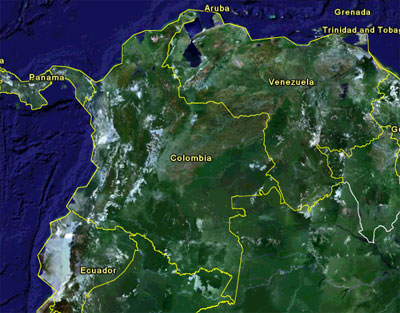ECUADOR
| Ecuador Forest Figures
Forest Cover Total forest area: 10,853,000 ha % of land area: 39.2% Primary forest cover: 4,794,000 ha % of land area: 17.3% % total forest area: 44.2% Deforestation Rates, 2000-2005 Annual change in forest cover: -197,600 ha Annual deforestation rate: -1.7% Change in defor. rate since '90s: 16.7% Total forest loss since 1990: -2,964,000 ha Total forest loss since 1990:-21.5% Primary or "Old-growth" forests Annual loss of primary forests: n/a Annual deforestation rate: n/a Change in deforestation rate since '90s: n/a Primary forest loss since 1990: n/a Primary forest loss since 1990:0.0% Forest Classification Public: 77.1% Private: n/a Other: 22.9% Use Production: 1.5% Protection: 21.5% Conservation: 44.2% Social services: n/a Multiple purpose: 18.9% None or unknown: 13.8 Forest Area Breakdown Total area: 10,853,000 ha Primary: 4,794,000 ha Modified natural: 5,895,000 ha Semi-natural: n/a Production plantation: 164,000 ha Production plantation: n/a Plantations Plantations, 2005: 164,000 ha % of total forest cover: 1.5% Annual change rate (00-05): 560,000 ha Carbon storage Above-ground biomass: n/a M t Below-ground biomass: n/a M t Area annually affected by Fire: n/a Insects: n/a Diseases: n/a Number of tree species in IUCN red list Number of native tree species: 1,000 Critically endangered: 240 Endangered: 669 Vulnerable: 923 Wood removal 2005 Industrial roundwood: 1,360,000 m3 o.b. Wood fuel: 6,979,000 m3 o.b. Value of forest products, 2005 Industrial roundwood: $93,193,000 Wood fuel: $45,785,000 Non-wood forest products (NWFPs): n/a Total Value: $138,978,000 More forest statistics for Ecuador |
Ecuador also has the distinction of having the highest deforestation rate and worst environmental record in South America. Oil exploration, logging, and road building have had a disastrous impact on Ecuador's primary rainforests, which now cover less than 15 percent of the country's land mass.
Logging in Western Ecuador (coastal and low Andean) areas is responsible for the loss of 99 percent of the country's rainforest in this region. Historically, after an area has been selectively logged and abandoned, settlers follow logging roads and set up homesteads, slashing and burning the surrounding forest for agriculture and cattle pasture.
The impact of oil exploitation in Eastern Ecuador is now notorious as a result of a long-running multi-billion dollar lawsuit involving 30,000 Amazon forest dwellers and Texaco, once one of the world's largest energy companies but now part of Chevron. In the 25 years that Texaco operated in the Oriente region of the Western Amazon, the oil company allegedly spilled 17 million gallons of crude oil into the local river systems (by comparison, the Exxon Valdez spilled 11 million gallons in Alaska in 1989), dumped more than 20 billion gallons of toxic drilling by-products, and cleared forest for access roads, exploration, and production activities. As of the mid-1990s, lands once used for farming lay bare and hundreds of waste pits remained. In August 1992, a pipeline rupture resulted in a 275,000-gallon spill, which caused the Rio Napo to run black for days and forced downstream Peru and Brazil to declare national states of emergency for the affected regions.
Originally it appeared that Texaco might pull out of the Oriente without reparations to the people whose environment was so seriously degraded, but widespread protests by Indigenous peoples, environmentalists, and human-rights organizations forced Texaco into negotiations. Texaco projected its clean-up costs at a moderate US$5-10 million.
In response to widespread environmental degradation and serious health problems among local peoples, a class-action lawsuit was filed against Texaco in the United States on behalf of 30,000 people affected by the oil company's operations. That lawsuit is still ongoing.
In total, between 1990 and 2005, Ecuador lost about 21.5 percent of its forest cover. The deforestation rate has increased by 17 percent since the close of the 1990s.
Recent articles | Ecuador news updates | XML
Suggested reading - Books
- Lonely Planet Ecuador & the Galapagos Islands
- Rough Guide to Ecuador
- Culture Shock! Ecuador: A Guide to Customs & Etiquette
- Birds of Ecuador Field Guide
- Moon Handbooks Ecuador
- Ecuador and the Galapagos Islands
- Savages
- Amazon Stranger: A Rainforest Chief Battles Big Oil
- Maiz y Coca-Cola: Adventures, Scrapes, and Shamanism in the Amazon and Andes
- Tropical Nature : Life and Death in the Rain Forests of Central and South America
- A Neotropical Companion
- Mammals of the Neotropics (Volume 3 ): The Central Neotropics: Ecuador, Peru, Bolivia, Brazil
Unless otherwise specified, this article was written by Rhett A. Butler [Bibliographic citation for this page]
Other resources
Contact me if you have suggestions on other rainforest-related environmental sites and resources for this country.

Image copyright Google Earth, MDA EarthSet, DigitalGlobe 2005
CIA-World Factbook Profile
FAO-Forestry Profile
Last updated: 7 Feb 2006
